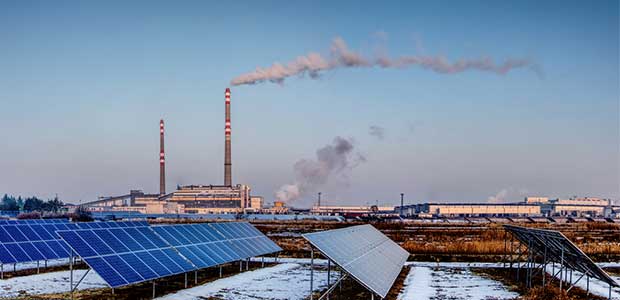
For the First Time, Renewable Energy is Expected to Surpass Coal in the U.S.
The coronavirus pandemic has caused hardships on many industries—the fossil fuel and clean energy industries alike. However, this is the first time in history that renewable energy use is expected to eclipse coal reliance in the U.S., and its effects on climate change are big.
- By Amanda Smiley
- May 15, 2020
As one of the biggest contributors to the globe’s greenhouse gas emissions, the United States has never prioritized renewable energy over fossil fuels and coal. However, as a result of the coronavirus pandemic (and decreasing costs of renewable energy processes and recent climate change efforts), the U.S. is projected to become more reliant on renewable energy than coal for the first time ever.
One New York Times article breaks this change down. New government projections show a transformation in energy reliance driven by many factors, including the coronavirus and recent climate change efforts. The recent change to a priority of renewable energy is quite the feat for the U.S.—especially given it is one of the biggest coal countries in the world and, ten years ago, coal was so dominant that it provided nearly half the nation’s electricity.
Like most environmental discussions, there are a number of reasons for this shift. Of course, the coronavirus has shut down the operation of many U.S. coal plants, but since 2010, many coal plants have retired from economic hardships.
However, renewable energy is both a survivor of the coronavirus pandemic (economically) and an increasingly affordable industry. The cost of building large wind farms has declined over 40 percent in the last 10 years, while solar costs have dropped more than 80 percent. The price of natural gas—a cleaner-burning alternative to coal—has fallen to historic lows as a result to the fracking boom.
Taking a more specific look at how the coronavirus has affected energy industries give us more insight into the future of the country.
During the pandemic, demands for electricity have fallen sharply as factories, restaurants and offices closed nationwide. Because coal plants often cost more to operate than gas plants or renewables, many utilities are cutting back on coal power first in response.
“The outbreak has put all the pressures facing the coal industry on steroids,” said Jim Thompson, a coal analyst at IHS Markit.
But while coal has been burning out, renewables have been doing better than ever. In just the first four and a half months of 2020, America’s wind power, solar power and hydroelectric dams have produced more electricity than coal on 90 separate days—which is more than twice last year’s record (at 38 days). In Texas on May 1, wind power alone supplied nearly three times as much electricity as coal, according to the article.
Projections for the rest of the year favor the success of renewables, too. The latest report from the Energy Information Administration (EIA) estimates that the U.S.’s total coal consumption will fall by nearly one-quarter in 2020. Coal plants are expected to provide just 19 percent of the nation’s electricity, dropping below both nuclear power and renewable power for the first time ever.
A shift like that would make the U.S. like some other countries that have already made renewable energy a priority source of energy, like Ireland. But the U.S. is still not yet to the point that Britain is, where the country goes days or weeks at a time without using any coal power at all.
This year in the U.S., natural gas is expected to hold its output (at 38 percent of the country’s power), thanks to fuel prices. Many environmentalists argue that natural gas is still a dirty process that harms the environment, but many also acknowledge it is a healthier system than coal. Nonetheless, a dominance of natural gas over coal is unprecedented.
While this shift is due, in part, to the coronavirus, coal’s recent decline over the last decade has already had positive impacts on the environment and other energy industries. As the dirtiest of all fossil fuels, its decline since 2005 has helped drive down the U.S.’s carbon emissions by nearly 15 percent. This year, the agency expects America’s emissions to fall by another 11 percent—the largest drop in 70 years.
Again, this is due in part to the pandemic, but also the country’s overall reduction in reliance on fossil fuels and decreasing costs of renewable energy. In fact, a number of utilizes and large technology companies (major consumers of electricity) are increasing their focus on wind and solar energy—largely because they are becoming more affordable.
“The grid is changing so much faster than anyone expected,” said Daniel Cohan, an associate professor of civil and environmental engineering at Rice University. “A decade ago, I was teaching my students that coal was the ‘baseload’ source that runs all the time, and solar was something you might sprinkle in if you want to pay more. Now coal’s been pushed to the margins and it’s wind and solar that are the cheapest options.”
Technology in the renewable industry has been improving too. Year ago, companies worried that a lack of sun at night would hurt their production of power, but developments in technology (like better weather forecasting and increased battery storage) and other forms of energy like natural gas can be used to meet spikes in demand.
Many analysts, environmentalists and economics have varying projections on how the coal industry will rebound (either by a little or a lot) in the coming years. Even still, the EIA does not see coal overtaking renewable energy.
“In some parts of the country, we’re now seeing renewable penetration hit 60 or 70 percent on some days,” said Nat Kreamer, chief executive of Advanced Energy Economy, a clean-energy business group, “and no one’s screaming that they can’t do that.”
About the Author
Amanda Smiley is the Content Editor for Occupational Health Magazine and Environmental Protection for 1105 Media. You can reach her at asmiley@1105media.com.